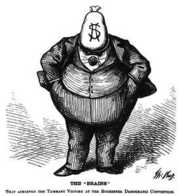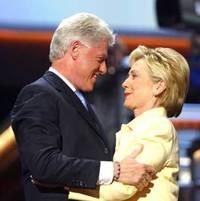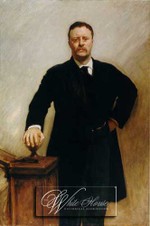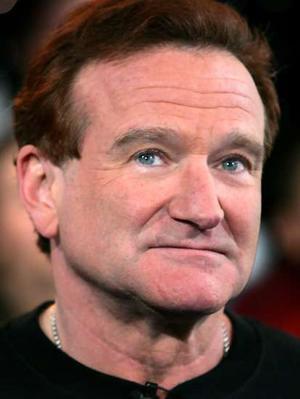Following is the essay you can designate as Volume 10, Number 42 of
This Week’s Clue, based on the e-mail newsletter I have produced since
March, 1997. It would be the issue of October 22.
Enjoy.

The United States actually has, and always has had, three main political parties.
- The Republican Party.
- The Democratic Party.
- The Money Party.
While the Money Party has been associated with Republicans for a generation, its support can actually float. Even a split within the Money Party, as in 1992, can elect a Democrat. As it elected Bill Clinton. As, in 1912, it elected Woodrow Wilson. As, in 1884, it elected Grover Cleveland. Or, as in 1840, William Henry Harrison.
The Money Party is the true swing vote in America. And the Money Party almost always wins.
While voters this year have been switching allegiance, moving from Republican to Democratic (time will tell how permanent this is) the Money Party has been on the same course. Democratic campaign committees are now out-raising their Republican counterparts. Democratic Presidential candidates the same.
The Money Party has been in charge of the Democratic apparatus since about 1988, after successive Democrats lost and the party became anxious to win. The AntiThesis of our generation represents this alliance. Michael Dukakis was a candidate of the Money Party, or at least its Democratic wing. So was Bill Clinton. You can thus call this the Money Wing of the Democratic Party. When bloggers like Atrios complain about "The Village" they’re talking about the Money Wing of the party, which only leans against the Republican Thesis, which will only act as an AntiThesis, and which can’t conceive of real change.
lost and the party became anxious to win. The AntiThesis of our generation represents this alliance. Michael Dukakis was a candidate of the Money Party, or at least its Democratic wing. So was Bill Clinton. You can thus call this the Money Wing of the Democratic Party. When bloggers like Atrios complain about "The Village" they’re talking about the Money Wing of the party, which only leans against the Republican Thesis, which will only act as an AntiThesis, and which can’t conceive of real change.
When Howard Dean (left) said he wanted to represent "the Democratic wing of the Democratic party" he meant to stand against the Money Wing. (It wasn’t the Scream that killed Dean. It was the Money Wing, which was always looking for the "anti-Dean," and aligned with Kerry after Iowa.) When the Clintons moved to New York after 2000, it was to be nearer the offices of that Money Wing, to encourage its movement toward the Democrats.

What does the Money Party stand for? It stands for stability. It
stands for incremental change. It stands for the preservation of
capital. All good things in the abstract. In practice it means change
may come too slowly to be truly meaningful. Franklin D. Roosevelt’s
limited economic success during the New Deal was based on the
opposition of the Money Party, and his instinct to accommodate it,
because that was the real party his family belonged to. It was the same
party his distant cousin Theodore Roosevelt belonged to. Progressivism,
the slogan both Roosevelts ran on, is essentially measured reform
leaning against the interests of the Money Party.
Think of the Money Party’s role in both parties as Thesis and
AntiThesis, only told across centuries rather than generations. When
the Money Party has allied with Democrats, as it did with Cleveland,
Wilson, or during the New Deal, it was leaning into the wind of its
instincts, acting as an AntiThesis. When the Money Party has allied
with Republicans, as it has the last 40 years, its interests are
completely dominant. The public interest is replaced by ideological
interest, and it is the abandonment of those ideological interests by
the Money Party which has given Democrats their current opportunity.
What Democrats face today is a choice between the Money Wing and the
Democratic Wing of the Democratic Party. The Money Wing offers power,
and it offers reform, albeit incremental reform, Theodore
Roosevelt-style reform. The Democratic Wing offers more rapid change,
and a willingness to stand up against the Money Party (at least
rhetorically), as under Franklin Roosevelt.
Most Democrats today prefer the assured victory of the Money Wing
to the riskier but greater win which can be achieved by the Democratic
Wing, according to all polls. This is because they are being
deliberately misled.
The Republican Party is at its lowest ebb since 1932. Its chances of
victory next year are virtually nil. But because the Republican
Party-Money Party alliance has been so strong, for so long, the media
(all of which answers to the Money Party) continues to build up its
chances for victory, and in so doing assures a Clinton-Money alliance
victory. It also helps that all our media, whether nominally Republican
or nominally Democrat, belongs in the end to the Money Party.

It is possible that Hillary Clinton, as President, will be more like
Franklin Roosevelt than Richard Nixon. But I think now it’s far more
likely she’ll govern like Theodore Roosevelt, supporting reform, but
holding it in check, maintaining the Money Party’s 200-year old
monopoly on American political power.
Our politics today, then, becomes a mirror image of what it was 110 years ago. Instead of two wings of Republicans facing Democratic Populists, we have two wings of Democrats facing Republican Populists. Instead of being led by a Manly Man, as 100 years ago, it’s led by a Womanly Woman.
But the power behind the throne remains the same. Money.









